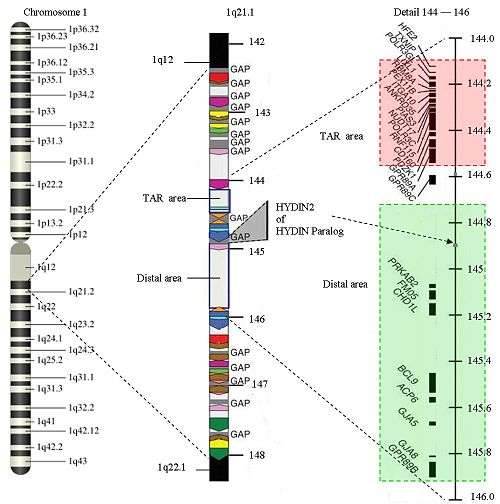TAR syndrome
| TAR Syndrome (Thrombocytopenia with Absent Radius) | |
|---|---|
| Specialty |
Medical genetics |
TAR Syndrome (thrombocytopenia with absent radius) is a rare genetic disorder that is characterized by the absence of the radius bone in the forearm and a dramatically reduced platelet count.
Presentation
- Symptoms of thrombocytopenia, or a lowered platelet count, leads to bruising and potentially life-threatening hemorrhage.[1]
- absence of the radius bone in the forearm with preservation of the thumb
Other common links between people with TAR seem to include anemia, heart problems, kidney problems, knee joint problems, frequently lactose intolerance.
Different cases with leukemia in patients with TAR are described in.[2]

Genetics
A 2007 research article identified a region of chromosome 1, 1q21.1, containing 11 genes (including HFE2, LIX1L, PIAS3, ANKRD35, ITGA10, RBM8A, PEX11B, POLR3GL, TXNIP, and GNRR2), that is heterozygously deleted in thirty of thirty patients with TAR.[3] This deletion was also found in 32% of unaffected family members, indicating that the condition requires an additional modifier.
This modifier was discovered in 2012. A study identified two separate single-nucleotide polymorphism (SNP) in RBM8A. These abnormalities resulting in reduced Y14 production that were responsible for all but two of the cases studied, one a 5'UTR SNP with a frequency of 3.05% and the other an intronic SNP with a frequency of 0.42% in 7504 healthy individuals of the Cambridge BioResource. The microdeletion was not found in 5919 controls of the Wellcome Trust Case Control Consortium.[4]
Treatment
Treatments range from platelet transfusions to surgery aimed at either centralizing the hand over the ulna to improve functionality of the hand or aimed at 'normalizing' the appearance of the arm, which is much shorter and 'clubbed.' There is some controversy surrounding the role of surgery. The infant mortality rate has been curbed by new technology, including platelet transfusions, which can even be performed in utero. The critical period is the first and sometimes second year of life. For most people with TAR, platelet counts improve as they grow out of childhood.
Epidemiology
The incidence is 0.42 per 100,000 live births.
History
In 1929 Greenwald and Sherman described the first patient with TAR Syndrome.[5] 40 years later Hall collected 40 cases and introduced the name "Thrombocytopenia with absent radius".[6] In 1988 Hedberg published an article with 100 cases.[7]
The bigenetic background was described in 2007[3] and 2012.[4]
References
- ↑ Manukjan, Georgi; Bösing, Hendrik; Schmugge, Markus; Strauß, Gabriele; Schulze, Harald (2017-08-31). "Impact of genetic variants on haematopoiesis in patients with thrombocytopenia absent radii (TAR) syndrome". British Journal of Haematology. doi:10.1111/bjh.14913. ISSN 1365-2141. PMID 28857120.
- ↑ Jameson-Lee, Maximilian; Chen, Katherine; Ritchie, Ellen; Shore, Tsiporah; Al-Khattab, Omar; Gergis, Usama (2017). "Acute myeloid leukemia in a patient with thrombocytopenia with absent radii: A case report and review of the literature". Hematology/Oncology and Stem Cell Therapy. doi:10.1016/j.hemonc.2017.02.001.
- 1 2 Klopocki E, Schulze H, Strauss G, et al. (2007). "Complex Inheritance Pattern Resembling Autosomal Recessive Inheritance Involving a Microdeletion in Thrombocytopenia–Absent Radius Syndrome". Am. J. Hum. Genet. 80 (2): 232–40. doi:10.1086/510919. PMC 1785342. PMID 17236129.
- 1 2 Albers CA, Paul DS, Schulze H, Freson K, Stephens JC, Smethurst PA, Jolley JD, Cvejic A, Kostadima M, Bertone P, Breuning MH, Debili N, Deloukas P, Favier R, Fiedler J, Hobbs CM, Huang N, Hurles ME, Kiddle G, Krapels I, Nurden P, Ruivenkamp CA, Sambrook JG, Smith K, Stemple DL, Strauss G, Thys C, van Geet C, Newbury-Ecob R, Ouwehand WH, Ghevaert C (2012). "Compound inheritance of a low-frequency regulatory SNP and a rare null mutation in exon-junction complex subunit RBM8A causes TAR syndrome". Nat. Genet. 44: 435–9, S1–2. doi:10.1038/ng.1083. PMC 3428915. PMID 22366785.
- ↑ H. M. Greenwald, J. Sherman (1928). "Congenital essential thrombocytopenia". Am J Dis Child. 38: 1245. doi:10.1001/archpedi.1929.01930120123011.
- ↑ Hall, J. G.; Levin, J.; Kuhn, J. P.; Ottenheimer, E. J.; van Berkum, K. A.; McKusick, V. A. (November 1969). "Thrombocytopenia with absent radius (TAR)". Medicine. 48 (6): 411–439. doi:10.1097/00005792-196948060-00001. ISSN 0025-7974. PMID 4951233.
- ↑ JM, Hedberg VA and Lipton (1988). "Thrombocytopenia with absent radii. A review of 100 cases". Am J Pediatr Hematol Oncol. 10: 51–64. PMID 3056062.
Further reading
- Goldfarb, Charles A.; Wall, Lindley; Manske, Paul R. (Sep 2006). "Radial Longitudinal Deficiency: The Incidence of Associated Medical and Musculoskeletal Conditions". The Journal of Hand Surgery. 31 (7): 1176–1182. doi:10.1016/j.jhsa.2006.05.012. PMID 16945723.
External links
| Classification |
|---|